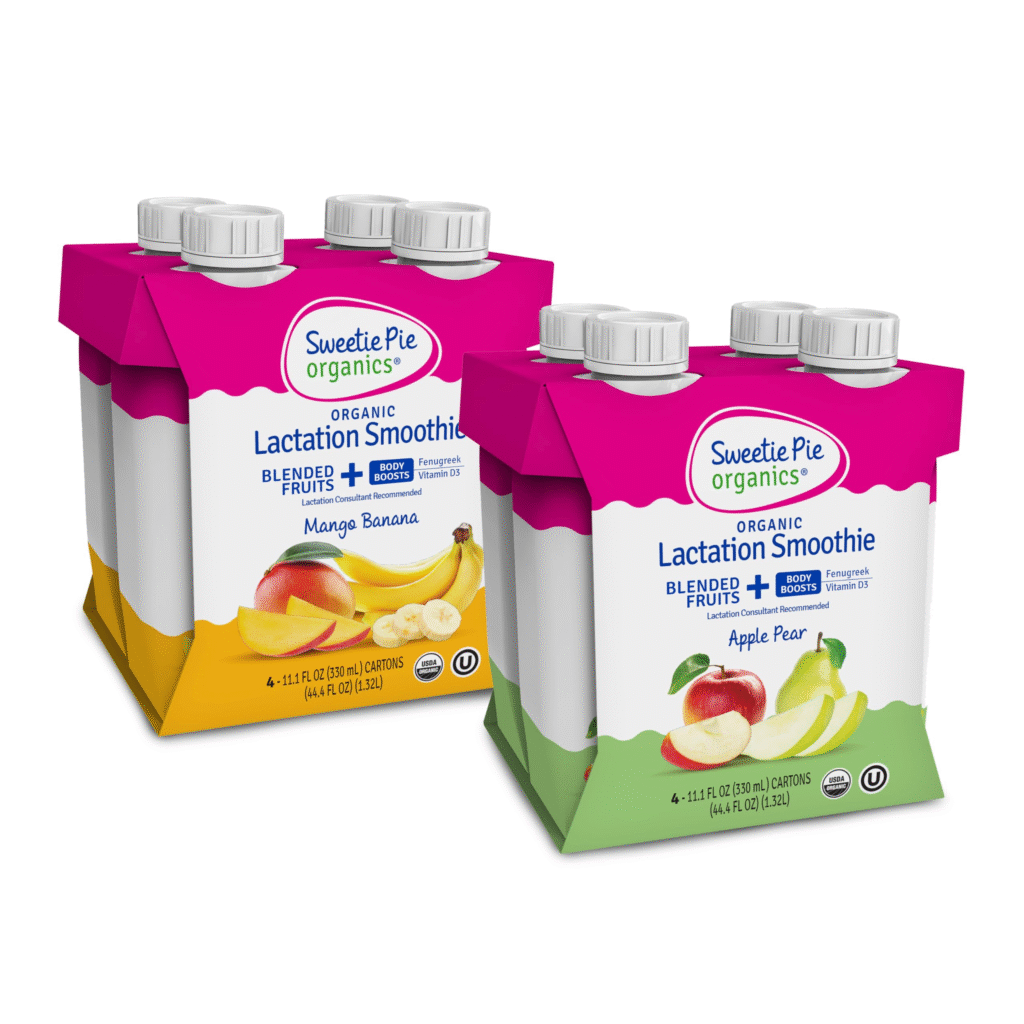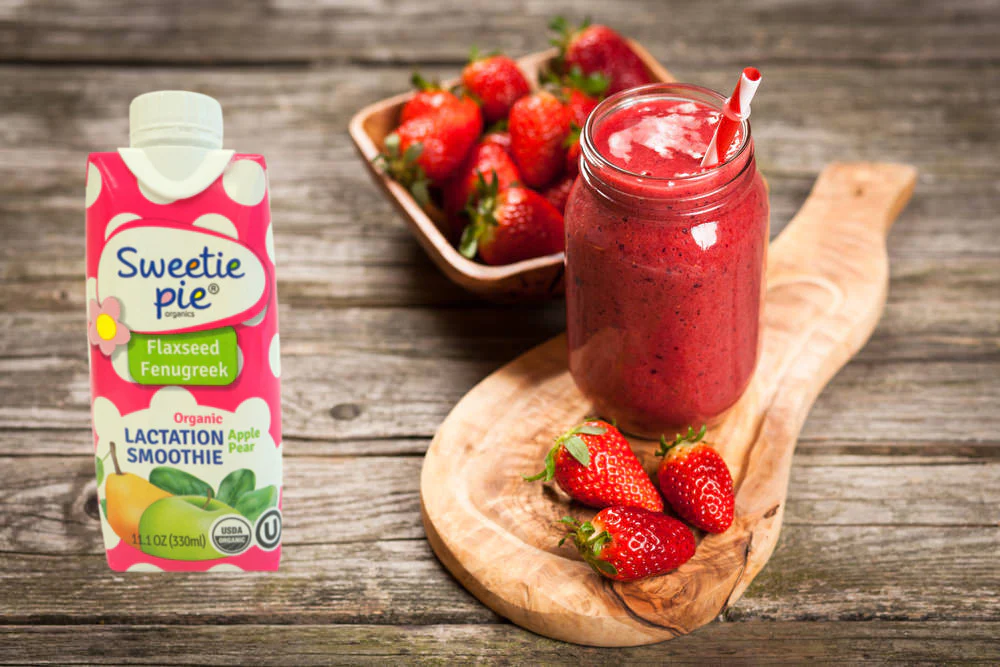Contents
- 1 What Are Lactation Smoothies?
- 2 How (and Whether) They Work — the Evidence & Mechanisms
- 3 Key Ingredients / What to Include (and Why)
- 4 Sample Recipes
- 5 How to Use Them (Timing, Frequency, etc.)
- 6 PROS AND CONS of Lactation Smoothies
- 7 Review — What’s the Experience Among Mothers & Experts
- 8 How to Evaluate Whether It’s Working for You
- 9 Tips to Make Better Lactation Smoothies
- 10 Sample 7-Day Plan (for someone wanting to try)
- 11 Final Thoughts
- 12 Brands & Products to Know
What Are Lactation Smoothies?
Lactation smoothies are blended drinks intended for breastfeeding (or pumping) mothers, formulated with ingredients thought to support milk production (so-called “galactagogues”) alongside nourishing macros (protein, healthy fats, fiber) and hydration. The idea is to combine convenience + nutrition + possible milk-boosting support into a drink you can sip on the go.
In practice, they’re smoothies just like any other, except the ingredient choices emphasize oats, seeds, nuts, leafy greens, herbs, etc.
They are not magic — but many moms use them as one tool (among others) to help maintain or increase supply.

How (and Whether) They Work — the Evidence & Mechanisms
Theoretical basis / common rationale
The rationale behind lactation smoothies is:
- Some foods/herbs are traditionally considered “galactagogues” (i.e. promoting milk production), e.g. oats, fenugreek, brewer’s yeast, flaxseed, fennel, sesame, alfalfa, etc.
- These ingredients may provide nutrients (iron, B-vitamins, magnesium, plant estrogens, phytoestrogens) that support overall maternal health, which could indirectly support milk production.
- Blending into smoothies improves convenience and helps ensure you get enough calories, protein, and hydration — all essential when breastfeeding.
However:
- The scientific evidence for many galactagogues is limited, mixed, or based on small studies or traditional practice.
- Milk supply is influenced by many factors (baby’s latch, frequency of feeding/pumping, maternal health, hydration, stress, hormonal factors).
- A lactation smoothie alone is unlikely to make a large difference if underlying issues (poor latch, low demand) are not addressed.
Healthline notes that while some foods may help, the evidence is still primarily anecdotal or limited.
Also, promotional or blog sources often present herbal claims without strong human trial backing.
So treat them as low-risk supportive nutrition rather than “cure-all.”

Coquitlam Centre
Key Ingredients / What to Include (and Why)
Here are commonly used ingredients in lactation smoothies, and why they are chosen:
| Ingredient | Potential benefit / rationale | Notes / cautions |
|---|---|---|
| Oats / rolled oats | Rich in iron, fiber, complex carbs; often cited as a milk-supportive food in anecdotal sources. Many recipes use oats to thicken and add energy. | Use gluten-free oats if you have sensitivity; soak or cook if needed for easier digestion |
| Flaxseed / ground flax | Provides omega-3s, fiber, and phytoestrogens; many recipes include it. | Use ground flaxseed for better absorption; too much fiber may cause digestive discomfort |
| Brewer’s yeast | Rich in B-vitamins and protein; often used in “lactation cookie” recipes and smoothies. | Some may find its taste strong; ensure it doesn’t conflict with any medications |
| Herbs such as fenugreek, fennel, alfalfa | Traditional galactagogues; fenugreek especially is among the most studied. | Fenugreek can have side effects (e.g., body odor, GI upset); avoid if allergic |
| Leafy greens / spinach / kale | Provide vitamins, minerals (iron, calcium, folate) | Good for overall nutrition; typically not directly “milk boosting” |
| Nuts / nut butter (almond, peanut, cashew) | Healthy fats, protein, minerals | Use small amounts if allergy is a concern |
| Seeds (chia, sesame, hemp, sunflower, etc.) | Healthy fat, fiber, trace minerals | Grind or soak for better absorption |
| Fruits | For flavor, vitamins, natural sweetness (berries, banana, mango, etc.) | Moderation if sugar intake is a concern |
| Liquid base (milk, plant milk, water, coconut water, kefir, etc.) | Hydration + deliver macronutrients | Use fortified non-dairy milk if dairy-free; ensure sufficient protein if using water-only base |
| Extras / spices (cocoa, cinnamon, turmeric, ginger, vanilla, etc.) | Flavor + antioxidant / anti-inflammatory benefits | Use moderate amounts |
Many lactation smoothie recipe collections use combinations of the above. For example: PB&J lactation smoothie (almond milk, banana, oats, peanut butter, brewer’s yeast); or “Triple fruit lactation support smoothie” using oats + oat milk + berries + flax + spinach
Sample Recipes
Here are a few tried recipes/examples to get you started (adapt to your taste, dietary restrictions, etc.):
Recipe 1: Triple Fruit Lactation Support Smoothie
- 1 small banana
- ½ cup blackberries
- ¼ cup blueberries
- 1 tbsp ground flaxseed
- ½ cup rolled oats
- ½–¾ cup oat milk
- 1 cup spinach
Blend until smooth.
Recipe 2: PB&J Lactation Smoothie
- 1 cup almond milk
- ½ frozen banana
- 1/3 cup rolled oats
- 1 cup frozen blueberries
- 2 tbsp peanut butter
- 1 tbsp brewer’s yeast
Blend until smooth.
Recipe 3: Dark Chocolate, Peanut Butter, and Banana
- 2 cups almond milk
- 1 frozen banana
- 2 tbsp cocoa powder
- 2 tbsp peanut butter
- 1 tbsp ground flaxseed
- 1 tbsp brewer’s yeast
Blend until creamy.
Recipe 4: Pumpkin Spice Lactation Smoothie
- 1 cup almond milk
- ½ cup pumpkin puree
- ½ tsp cinnamon
- ¼ tsp nutmeg
- 1 tbsp ground flaxseed
- 1 tbsp brewer’s yeast
Blend until smooth.

How to Use Them (Timing, Frequency, etc.)
- You can drink a lactation smoothie as a meal replacement, snack, or in between feedings, depending on your calorie needs.
- Many mothers take one in the morning (as breakfast) or mid-afternoon.
- You can also have one before a pumping session (if you pump) to see if it helps.
- If making multiple servings, store leftovers in airtight containers in the fridge (consume within ~24 hours) or freeze portions.
- When reheating or thawing, shake or blend again to restore texture.
- Be consistent over days/weeks; don’t expect overnight miracles.
PROS AND CONS of Lactation Smoothies
Pros
- Potential mild boost: some individuals report improvements in supply, fullness of breasts, or improved let-down when using galactagogue ingredients.
- Palatability: many mothers find them delicious and easier to consume than large meals when busy or tired.
- Calorie & nutrient support: breastfeeding burns extra calories; smoothies can help meet those needs.
- Hydration: contributes to fluid intake (important for milk supply).
- Convenient nutrition: easy way to pack multiple beneficial ingredients
Cons
- Calorie excess: if used in large amounts, they can contribute to unwanted weight gain post-partum (if that’s a concern).
- Sugar content: smoothies with lots of fruit or added sweeteners may increase sugar intake.
- Herb-drug interactions / side effects: e.g. fenugreek may affect blood sugar, thyroid, interact with medications.
- Digestive discomfort: high fiber or seed content might cause gas or GI upset in some mothers.
- Over-reliance: they are supportive, not a substitute for addressing key breastfeeding principles (frequency, latch, demand).
- Allergies / sensitivities: nuts, seeds, herbs (e.g. fenugreek), dairy or alternative milks can cause issues for you or baby.
- Limited scientific validation: many galactagogue claims are anecdotal or based on weak evidence.
Review — What’s the Experience Among Mothers & Experts
From blogs, forums, and lactation-focused sites, here’s what many mothers report:
What works / what people like:
- Many say they “feel better fed / more energetic” when using smoothies consistently.
- Some mothers see a modest uptick in milk output (though hard to prove causality).
- They appreciate the convenience — blending takes little time and can be consumed during a feeding break.
- They like being able to “sneak in” good ingredients (greens, seeds) that might be harder to eat separately.
Criticisms / disappointments:
- Some mothers see no change in supply even after weeks.
- The taste or texture of certain ingredients (like brewer’s yeast, strong herbs) can be unpalatable to some.
- They can be calorie-dense, and if not balanced may lead to overconsumption.
- Inconsistent information: different sources recommend wildly different herbs or dosages.
- Some mothers find their babies react (gas, fussiness) to herbal ingredients.
Overall, mothers tend to see them as a “helpful supplement,” not a guarantee.
How to Evaluate Whether It’s Working for You
- Baseline measurement: track your milk output (if pumping) or baby weight gain / diaper output over a week before starting.
- Introduce one change at a time: e.g. add a smoothie daily for a week, while keeping feeding/pumping practices constant.
- Monitor trends over 1–2 weeks: look for increases in pumped volume, fullness, easier let-down, or baby’s weight gain.
- Be aware of confounders: stress, dehydration, sleep, latch changes, illness, or medications may impact supply.
- Get lactation support: consult an IBCLC or lactation consultant to ensure structural/technique issues aren’t the limiting factor.
- Stop or adjust if baby shows intolerance (gas, fussiness) or you experience side effects.
Tips to Make Better Lactation Smoothies
- Use frozen fruit to improve texture and reduce need for ice.
- Pre-measure & prep ingredients in freezer bags (e.g. oats + spinach + berries) to make blending faster.
- Use a high-powered blender to get seed & nut integrity without grit.
- Balance macronutrients: include a protein source (e.g. Greek yogurt, protein powder, nut butter) so your body doesn’t deplete its own stores.
- Use fortified non-dairy milks if dairy is avoided (to get calcium, B12, etc.).
- Introduce herbs slowly and in small amounts, especially if you or your baby haven’t had them before.
- Drink additional plain water — smoothies help, but you still need good hydration.
- Rotate ingredients — don’t rely on one blend every day.
- If freezing portions, leave a bit of headspace in the container for expansion.
Sample 7-Day Plan (for someone wanting to try)
| Day | Smoothie + Notes |
|---|---|
| Day 1 | Triple Fruit (fruit + oats + flax + spinach) |
| Day 2 | PB&J (peanut butter, oats, berries) |
| Day 3 | Greens + avocado + seed blend (chia / flax) |
| Day 4 | Chocolate + banana + nut butter + oats |
| Day 5 | Pumpkin spice + oats + flax |
| Day 6 | Tropical mango / pineapple + spinach + seeds |
| Day 7 | Retry your favorite so far, adjust amounts |
Use as a meal or snack, track output or sensations of fullness, and watch baby’s response.
Final Thoughts
- Lactation smoothies can be a useful, low-risk nutritional support tool for breastfeeding mothers, combining helpful ingredients with hydration and calories.
- They are not a guarantee; their efficacy depends heavily on other factors like feeding technique, frequency, and maternal health.
- Use them as part of a holistic strategy: good latch, frequent feeding, rest, hydration, and professional support.
- If you try them, do so consistently over at least 1–2 weeks and monitor measurable changes.
- Always check herb use (especially fenugreek) with your provider, especially if you have medical conditions or take medications.
Brands & Products to Know
| Product / Brand | Description / Key Features | Pros & Considerations |
|---|---|---|
| UpSpring Milkflow Drink Mix | A popular powdered drink mix you add to smoothies or water | Well known in the U.S., includes galactagogue ingredients. Good option if you want something to blend with your own smoothie base. |
| Premama Lactation Drink Mix | Premama (European / international brand) lactation support drink mix / powder | May be more accessible (shipping / regulatory) in European markets. Check the ingredient list for herbs or allergens. |
| Legendairy Milk Liquid Gold | A concentrated lactation “liquid gold” additive (you add to your drink) | Convenient for boosting a smoothie without needing a full powder. Be cautious with concentrated dosages. |
| Legendairy Milk Lactivist | A product by Legendairy Milk line for lactation support | Combines multiple galactagogues; check the total dosage of herbs. |
READ ALSO: Difference between spectra s1 and s2

